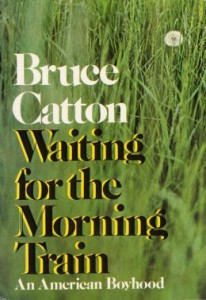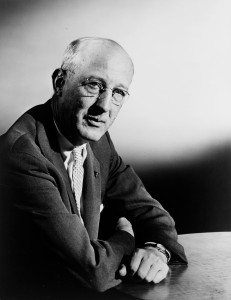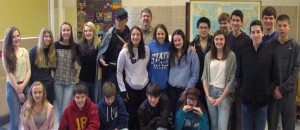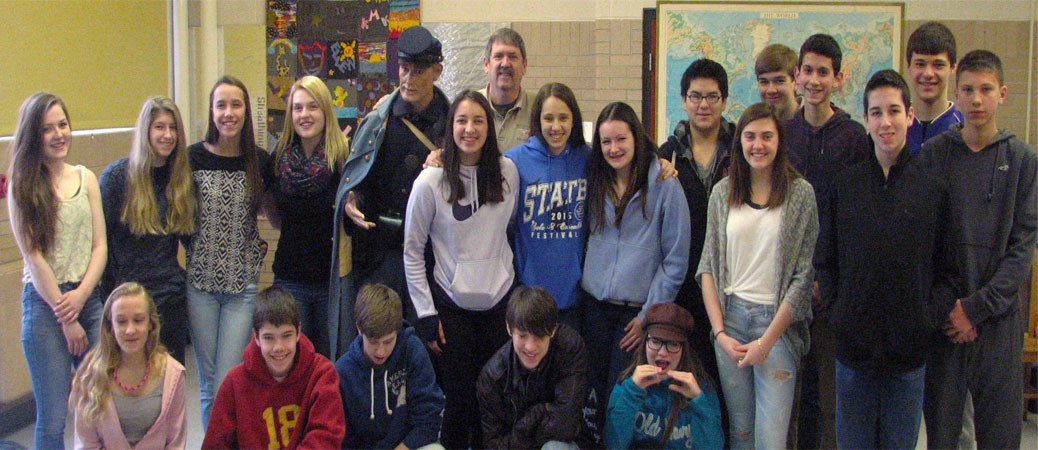By Stewart Allison McFerran, Benzie resident
Bruce Catton, the Pulitzer Prize-winning author born and raised in Benzonia, graduated from the Benzonia Academy in 1916. Nearly one-hundred years later, students from the Frankfort High School class of 2016 have written essays about their experiences and observations, in the style of Catton. Their essays will be read aloud in dramatic fashion at the Mills Community House, Benzonia, on April 8th at 7:30pm. The best essay will win the 9th annual Bruce Catton Historical Awards, coordinated by Kay Bos.

The Pulitzer Prize that Bruce Catton won is on display at the Benzie Area Historical Museum, across the street from the Mills Community House on the hill in Benzonia where Catton grew up. The Presidential Medal of Freedom that was given to him by Gerald Ford is also displayed there. But most important are the copies of his book, “Waiting for the Morning Train,” that are in the library for students to read.
 “Waiting for the Morning Train” is Catton’s memoir about growing up in Benzie County. It was written after he had served as a war correspondent in WWI and written books on the Civil War. Catton’s book, “A Stillness at Appomattox,” won the Pulitzer and has been widely read by people all over the world. It helped our Nation come to grips with the bloody Civil War.
“Waiting for the Morning Train” is Catton’s memoir about growing up in Benzie County. It was written after he had served as a war correspondent in WWI and written books on the Civil War. Catton’s book, “A Stillness at Appomattox,” won the Pulitzer and has been widely read by people all over the world. It helped our Nation come to grips with the bloody Civil War.
There is no one waiting at the train station in downtown Beulah at the moment. It has been over 50 years since The Frankfort and Southeastern Railroad has passed by, let alone stopped to pick up a passenger. Catton describes in “Waiting,” that the Catton Family rode the Pere Marquette Railroad to the depot in Thompsonville. From there they could change to the Chicago and West Michigan or the Ann Arbor . Riding the “Ping Pong” to Frankfort, the Cattons could board ferryboats to points West such as Manitowoc, Wisconsin. In all, a much slower-paced traveling experience than we have today.

Catton’s writing gives powerful images of life in Northern Michigan a century ago. While describing the idyllic life in Benzonia he shows how life and the land have changed. One big change was the arrival of the first car that drove up and stopped at a baseball game in Beulah. All the baseball players stopped to watch the car.
Concerning the land, fewer industries had an impact on Benzie County like the lumber industry. The sawdust from the mills covered the streams and smothered the fish spawning grounds. In “Waiting,” Catton wrote, “Despite his disclaimers, Man stands at the center of the Universe. It was made for him to use and the best and wisest are those who use it most. They destroy pine forests, dig copper mines and run open pits, impoverishing themselves at the same time they are enriching themselves: creating wealth, in short, by the act of destruction”.

American History teacher Dave Jackson and English teacher Rebecca Hubbard have taught about Bruce Catton and his place in the cannon of American Writers. Frankfort Juniors are urged to write about their experiences in Benzie County, and luckily are able to follow in Catton’s footsteps, both literally and literarily. The Betsie and Platte Rivers flow near the student’s houses. The points at which the rivers meet Lake Michigan are places the students gather. Catton changed our Nation with his writing and so can students in the class of 2016.
The youthful experiences of Bruce Catton informed his later writing, and we can all benefit from his insights on Nature and War. Youths growing up in Northern Michigan today can view the world through the Benzie prism as Bruce Catton once did. Frankfort student Casey Aldrich wrote about her adventure to the Clay pits and a stop at Franny’s Follies, and her classmate Bret Zimmerman left shore to troll the deep waters of Lake Michigan and returned with ten salmon over twenty pounds.
Catton did leave Benzonia after graduating and stated: “There was nothing to do but grow up; We could take our time about it. Let the morning train come whenever it chose. We could board at the proper time with confidence.”
Stewart Allison McFerran has a degree in Environmental Studies and worked with Frankfort students on a robotics project. He led an Antioch College environmental field program to the Great Lakes and worked as a naturalist at Innisfree. He worked as a deck hand for Lang Fisheries and currently is an instructor at NMC Extended Education program. He lives on a Benzie stream. He did graduate studies in science education and was a Research Associate at the Lawrence Berkeley Laboratory. He grew up on a Lake in Michigan where he caught and released many turtles from his rowboat “Mighty Mouse”. This is McFerran’s first contribution to Grand Traverse Journal.


Stewart, you wrote a great article about my hero, Bruce Catton. You also covered interesting details about Benzie County; its influence on Catton and the Frankfort students of today. Thank you!
Kay Bos